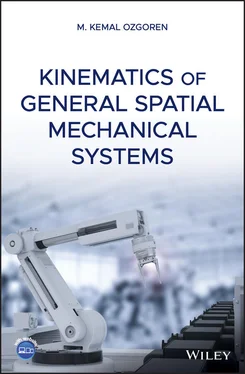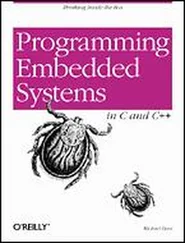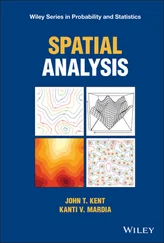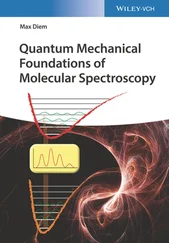M. Kemal Ozgoren - Kinematics of General Spatial Mechanical Systems
Здесь есть возможность читать онлайн «M. Kemal Ozgoren - Kinematics of General Spatial Mechanical Systems» — ознакомительный отрывок электронной книги совершенно бесплатно, а после прочтения отрывка купить полную версию. В некоторых случаях можно слушать аудио, скачать через торрент в формате fb2 и присутствует краткое содержание. Жанр: unrecognised, на английском языке. Описание произведения, (предисловие) а так же отзывы посетителей доступны на портале библиотеки ЛибКат.
- Название:Kinematics of General Spatial Mechanical Systems
- Автор:
- Жанр:
- Год:неизвестен
- ISBN:нет данных
- Рейтинг книги:4 / 5. Голосов: 1
-
Избранное:Добавить в избранное
- Отзывы:
-
Ваша оценка:
Kinematics of General Spatial Mechanical Systems: краткое содержание, описание и аннотация
Предлагаем к чтению аннотацию, описание, краткое содержание или предисловие (зависит от того, что написал сам автор книги «Kinematics of General Spatial Mechanical Systems»). Если вы не нашли необходимую информацию о книге — напишите в комментариях, мы постараемся отыскать её.
This all-time beneficial book:
Provides an easy-to-use systematic formulation method that is applicable to all sorts of spatial machanisms and manipulators Introduces a symbolic manipulation method, which is effective and straightforward to use, so that kinematic relationships can be simplified by using all the special geometric features of the system Offers an accessible format that uses a systematic and easy-to-conceive notation which has proven successful Presents content written by an author who is a renowned expert in the field Includes an accompanying website Written for academicians, students, engineers, computer scientists and any other people working in the area of spatial mechanisms and manipulators,
provides a clear notation, formulation, and a logical approach to the topic and offers a fresh presentation of challenging material.



 , i.e. if
, i.e. if  is perpendicular (or orthogonal or normal) to
is perpendicular (or orthogonal or normal) to  so that θ pq= π /2, then
so that θ pq= π /2, then  .
. , i.e. if | q | = | p | and θ pq= θ pp= 0, then
, i.e. if | q | = | p | and θ pq= θ pp= 0, then  . Hence, the magnitude of a vector
. Hence, the magnitude of a vector  can also be expressed as
can also be expressed as
 and
and  is denoted and defined as follows:
is denoted and defined as follows:
 to
to  . As for
. As for  , it is defined as a unit vector , which is perpendicular to the plane
, it is defined as a unit vector , which is perpendicular to the plane  formed by the vectors
formed by the vectors  and
and  .
. and
and  are skew (nonparallel) vectors, then
are skew (nonparallel) vectors, then  is formed by imagining that
is formed by imagining that  and
and  are translated toward each other until they are connected tail‐to‐tail. If
are translated toward each other until they are connected tail‐to‐tail. If  and
and  are parallel (but not coincident) vectors, then
are parallel (but not coincident) vectors, then  happens to be the plane that contains them. However, if
happens to be the plane that contains them. However, if  and
and  are coincident vectors, then
are coincident vectors, then  cannot be formed as a definite plane, i.e. it can be any plane that contains them.
cannot be formed as a definite plane, i.e. it can be any plane that contains them. is defined conventionally by the right‐hand rule . This rule is based on the right hand in such a way that
is defined conventionally by the right‐hand rule . This rule is based on the right hand in such a way that  assumes the orientation of the thumb (directed from root to tip) while the fingers are oriented from
assumes the orientation of the thumb (directed from root to tip) while the fingers are oriented from  to
to  .
. and
and  , the following equations can be written for the vectors involved in the cross product.
, the following equations can be written for the vectors involved in the cross product.

 with θ pq= 0 or
with θ pq= 0 or  with θ pq= π , then
with θ pq= π , then










